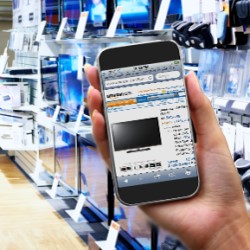Retailers who are good at connecting with their customers rely on many technologies like social media, email marketing, mobile applications and digital signage. Unfortunately, each of these tools operates independently so keeping your message synchronized and unified is a difficult task.
For example, promotions must be coordinated across every channel otherwise you can end up with conflicting information. You can't have digital signage screens displaying an expired promotion in your stores while your web site is showing entirely different ads. Same goes with coupons that are published via the web or on mobile applications.
If you're not coordinating the message across every channel, you run the risk of alienating your customers and that's when showrooming comes into play...
It's important to publish your content across every channel using a unified look and feel. It ties all of your communications together and reinforces your brand.
Retailers are putting a lot of effort to make this happen using the tools they have available but at some point we need all of these platforms to converge. We're already seeing a few digital signage applications that can communicate with PCs, Linux and Android devices. These applications let you publish content in a format that can be displayed on flat panel screens, tablets and digital frames.
When you're dealing with a single platform, it becomes much easier to deploy content across multiple channels in a coordinated manner. Until then, we need more checks and balances because consistency is the key!



